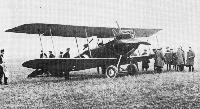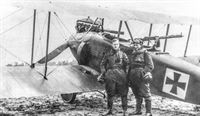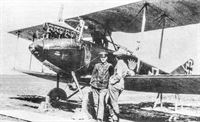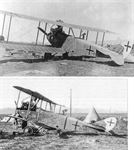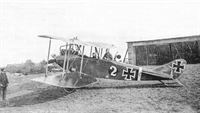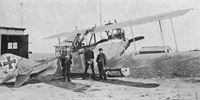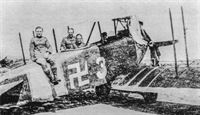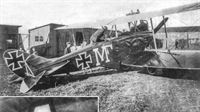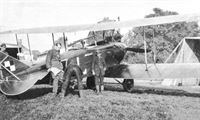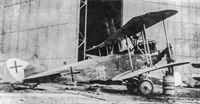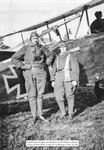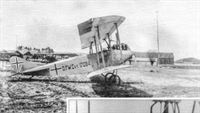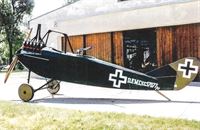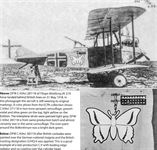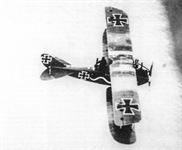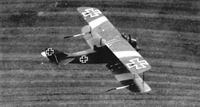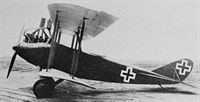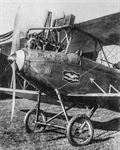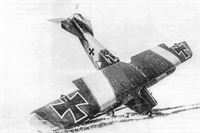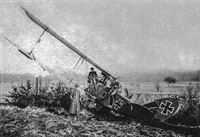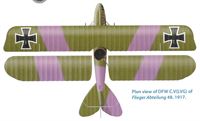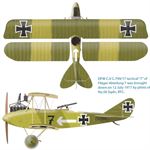
Описание
Страна: Германия
Год: 1916
Two-seat reconnaissance, artillery observation, infantry and photographic patrol
В.Кондратьев Самолеты первой мировой войны
DFW C-IV/C-V/C-VI/LVG C-VI
Цельнодеревянный двухстоечный биплан со смешанной обшивкой. Конструкция вполне типична для немецких двухместных аэропланов тех времен. Фюзеляж покрыт фанерой, крылья - полотном. Капоты алюминиевые. Стойки шасси и бипланной коробки - стальные трубы каплевидного сечения. На некоторых машинах двигатель был закапотирован полностью, включая цилиндры, и установлен кок винта. Автор проекта - главный конструктор фирмы Дойче Флюгцойгверк Генрих Эльрих. С начала 1916-го C-IV производили фирмы DFW и Авиатик.
В феврале 1916 года DFW C-IV начал поступать на фронт. Летом ему на смену пришел C-V со значительно более мощным мотором, позволившим резко поднять летные характеристики.
Самолет был прост в управлении и послушен пилоту любой квалификации. Он получил много хороших отзывов с фронта, благодаря чему производство C-V развернули сразу несколько фирм: DFW, Авиатик, Хальберштадт и Шютте-Ланц.
В начале 1917-го инженер-конструктор Мюссингброд перешел с фирмы DFW на LVG, организовав там лицензионный выпуск самолетов C-V. Машины, обозначенные LVG C-V отличались каплевидной формой вертикального оперения и несколько увеличенными размерами.
C-V выпускался крупными сериями и активно применялся на западном и восточном фронтах, а также в Северной Италии, Македонии, Месопотамии и Палестине.
Только во второй половине 1917 года на французском фронте действовало около 1000 машин этого типа. Они сыграли важную роль в битве под Аррасом и других операциях германской армии того периода. DFW оставались на вооружении частей первой линии вплоть до заключения перемирия.
Весной 1918-го разработан и запущен в серию DFW C-VI с 200-сильным мотором, каплевидным "эльфауговским" килем, роговой компенсацией элеронов и увеличенной кабиной летнаба (для удобства обращения с турельным пулеметом). Вскоре появился аналогичный LVG C-VI. Оба типа применялись одновременно и были очень похожи, что нередко приводило к ошибкам в идентификации.
Всего построено более 500 DFW C-VI и LVG C-VI.
После вывода немецких войск из Польши и Украины в конце 1918 - начале 1919 годов несколько десятков DFW и LVG различных модификаций осталось на территории этих новосозданных государств, которые тут же задействовали их в пограничных конфликтах друг против друга. Также есть данные о закупках таких машин Советской Россией и применении их в гражданской войне.
ДВИГАТЕЛЬ
220 л.с. (C-V) или 200 л.с. (C-VI).
ВООРУЖЕНИЕ
1 синхр. "Шпандау", 1 турельный "Парабеллум".
Описание:
- В.Кондратьев Самолеты первой мировой войны
- А.Александров, Г.Петров Крылатые пленники России
- O.Thetford, P.Gray German Aircraft of the First World War (Putnam)
- J.Stroud European Transport Aircraft since 1910 (Putnam)
- J.Herris DFW Aircraft of WWI (A Centennial Perspective on Great War Airplanes 29)
- Журнал Flight
Фотографии
-
J.Herris - DFW Aircraft of WWI /Centennial Perspective/ (29)
DFW C.V C.3xxx/16 of Schusta 8, July 1917 at Mousay Aerodrome. The stylized "W" is the unit insignia.
-
J.Herris - DFW Aircraft of WWI /Centennial Perspective/ (29)
DFW C.V 4918/16 of Flieger-Abteilung (A) 276.
-
J.Herris - Development of German Warplanes in WWI /Centennial Perspective/ (1)
DFW C.V 4918/16 serving with FA(A) 276, an artillery-spotting unit. The crew was Uffz. Decker and Lt. Hammer. DFW C.Vs had a long production run and later models had a radiator in front of the upper wing in place of the ear radiators on this example. Camouflage colors and schemes also varied over time and by sub-contractor.
-
J.Herris - DFW Aircraft of WWI /Centennial Perspective/ (29)
DFW C.V(LVG) 5159/16 tactical '2' of FliegerAbteilung (A) 211.
-
J.Herris - DFW Aircraft of WWI /Centennial Perspective/ (29)
Early production DFW C.V of an unknown unit.
-
J.Herris - DFW Aircraft of WWI /Centennial Perspective/ (29)
DFW C.V of Flieger Abteilung 48.
-
J.Herris - DFW Aircraft of WWI /Centennial Perspective/ (29)
DFW C.V(LVG) tactical '6' of an unknown Schusta.
-
J.Herris - DFW Aircraft of WWI /Centennial Perspective/ (29)
DFW C.V(LVG) of Flieger Abteilung 48. 1917.
-
В.Кондратьев - Самолеты первой мировой войны
DFW C-V, 48 (баварский) авиаотряд ВВС Германии, 1917г.
-
J.Herris - DFW Aircraft of WWI /Centennial Perspective/ (29)
DFW C.V C.4832/16 of Schusta 29b.
-
J.Herris - DFW Aircraft of WWI /Centennial Perspective/ (29)
DFW C.V(Av) C.9034/16 of FliegerAbteilung (A) 208.
-
J.Herris - DFW Aircraft of WWI /Centennial Perspective/ (29)
DFW C.V C.794/17 flown by 1. Marine Feld Flieger Abteilung, summer 1917.
-
J.Herris - DFW Aircraft of WWI /Centennial Perspective/ (29)
DFW C.V C.799/17 tactical "7" of FliegerAbteilung 7 was brought down on 12 July 1917 by pilots of No.56 Sqdn, RFC.
-
J.Herris - DFW Aircraft of WWI /Centennial Perspective/ (29)
DFW C.V(LVG) C.2164/17 with three-pointed star insignia from an unknown unit.
-
J.Herris - DFW Aircraft of WWI /Centennial Perspective/ (29)
Rudolf Stark's DFW C.V 6022/17 in Bavarian Flieger-Abteilung (A) 296. The observer was Ltn.d.R. Helmo Ludovici.
-
J.Herris - DFW Aircraft of WWI /Centennial Perspective/ (29)
DFW C.V(Av) C.287/18 of Flieger-Abteilung (A) 219, May 1918.
-
J.Herris - DFW Aircraft of WWI /Centennial Perspective/ (29)
DFW C.V(Av) C.287/18 of Flieger-Abteilung (A) 219, May 1918, after capture, assigned capture number G/HA/4, and over-painting of the German insignia by British cockades.
-
J.Herris - DFW Aircraft of WWI /Centennial Perspective/ (29)
DFW C.V 4430/18 of Flieger-Abteilung (A) 286b, May/June 1918. The unusual symbol was the unit marking and was copied from the emblem of a brewery.
-
J.Herris - DFW Aircraft of WWI /Centennial Perspective/ (29)
DFW C.V Gretel / Lo of Flieger Abteilung (A) 239, mid 1918.
-
J.Herris - DFW Aircraft of WWI /Centennial Perspective/ (29)
DFW C.V Hede flown by Feldwebel Henkel and Lt. Henschel of Flieger Abteilung (A) 253, late 1917. Hede was the name of their mechanic.
-
J.Herris - DFW Aircraft of WWI /Centennial Perspective/ (29)
Factory finish applied to Halberstadt-built C.V aircraft when fuselage was stained.
-
J.Herris - DFW Aircraft of WWI /Centennial Perspective/ (29)
DFW C.V(Halb) tactical "1" of FliegerAbteilung 44.
-
J.Herris - DFW Aircraft of WWI /Centennial Perspective/ (29)
DFW C.V with streaked camouflage if Flieger-Abteilung (A) 199b; crew and serial number unknown.
-
J.Herris - DFW Aircraft of WWI /Centennial Perspective/ (29)
DFW C.V flown by Lt. Bastian of 1. Marine Feld Flieger Abteilung.
-
R.Bennett - Last Gathering of Eagles 1918-1920 /Aeronaut/
DFW C.V, FA 426, Suwalki, May 1919.
-
J.Herris - DFW Aircraft of WWI /Centennial Perspective/ (29)
DFW C.V(Av) serial unknown of Flieger Abteilung (A) 208.
-
J.Herris - DFW Aircraft of WWI /Centennial Perspective/ (29)
Late production DFW C.V of an unknown unit, 1918. The aircraft wears late 1918-style markings and striped finish.
-
J.Herris - DFW Aircraft of WWI /Centennial Perspective/ (29)
DFW C.V of KG 2.
-
J.Herris - DFW Aircraft of WWI /Centennial Perspective/ (29)
DFW C.V C.7897/17 Wanda of the postwar Polish Air Service. The crew was Sergeant pilot Kazimierz Burzynski and observer Colonel Wladyslaw Anders, 12 Eskadra Wywiadowcza.
-
J.Herris - DFW Aircraft of WWI /Centennial Perspective/ (29)
DFW C.V of the Polish Air Service in 1920 flown by pilot Sgt. Wiktor Daniel & observer CpI. Mieczyslaw, III Eskadra Wielkopolska. One of 30 aircraft built for Poland as passenger planes, it was one of several adopted for combat in Poland with a Spandau for the pilot and a Lewis for the observer.
-
J.Herris - DFW Aircraft of WWI /Centennial Perspective/ (29)
DFW C.V of the Polish Air Service post-war.
-
J.Herris - DFW Aircraft of WWI /Centennial Perspective/ (29)
DFW C.V of the Estonian Air Service post-war.
-
J.Herris - DFW Aircraft of WWI /Centennial Perspective/ (29)
DFW C.V of the Latvian Air Service, 1924.
-
J.Herris - DFW Aircraft of WWI /Centennial Perspective/ (29)
DFW C.V of the Czech Air Force School, Cheb Aerodrome, ca. 1921; colors not confirmed.
-
J.Herris - DFW Aircraft of WWI /Centennial Perspective/ (29)
DFW C.V C.3311/16 was a C.V prototype or early production aircraft with ear radiators. The propeller lacks a spinner but the other C.V identification features are present. This photo became Sanke card 1042.
Early version of the DFW C.V produced in August 1916; assigned to Fl.-Abt.(A) 252w in April 1917. Note the housing around the engine. -
J.Herris - DFW Aircraft of WWI /Centennial Perspective/ (29)
A prototype DFW C.V in front of the DFW factory. The first three prototype C.V aircraft are thought to have serials C.3300-3302/16, the first three serials from the first production batch of 60 aircraft ordered from DFW. The C.V was a sturdy, two-bay biplane powered by a 200 hp Benz Bz.IV. The prototypes and early production aircraft featured ear radiators; later production aircraft had a leading edge radiator for improved reliability and reduced drag.
-
J.Herris - Development of German Warplanes in WWI /Centennial Perspective/ (1)
Aviatik-built DFW C.V(Av) at Adlershof for the type test in February 1917. The early company logo plate is visible on the side of the engine cowling.
Although the observer was in the rear cockpit with a better field of fire than the Aviatik C.II, the C.II could easily have been modified to the observer in back configuration. However, the modified Aviatik C.II would not have matched the DFW's excellent maneuverability and handling, and only 75 production Aviatik C.IIs were built. A total of 3,955 DFW C.Vs were built, more than any other WW1 German warplane. Of that total, Aviatik built 1,400 machines to 12 production orders. -
Журнал - Flight за 1917 г.
A D.F.W. biplane as built by the Aviatik works. It will be noticed that the wings are no longer swept back, otherwise the machine follows closely along the lines of the prewar type D.F.W. biplanes. The engine in this instance is a 225 h.p. Benz 6-cyl., with exhaust collectors. Two machine guns are carried, one firing forward "through" the propeller, and the other on a turntable in the rear cockpit.
-
Jane's All The World Aircraft 1919 /Jane's/
Front View of the captured D.F.W. Aviatik in Paris. - The shape of the nose shows clearly how the Germans obtained better propeller efficiency than we did, and also how, by fitting their radiators directly in the slip stream, they managed to run big engines with small radiators. These points contrasted favourably with our own contemporary methods.
-
A.Imrie - German Bombers /Arms & Armour/
At various periods some Kasta used a number of C category two-seaters to augment their normal establishment of six twin-engined bombers, employing them on short-range day and night operations. The most used machine for this purpose was the DFW C V, over 1,000 of which were at the Front by the end of August 1917; shown here is an aircraft of this type from Kasta 8, Kagohl II. During 1918 in order to provide a low-altitude day bombing force (also used in the Schlachtstaffel role) - for which the large twin-engined machines were unsuitable - Kogenluft increased the establishment of each Bosta to include three C type aircraft with a further three held in reserve.
-
J.Herris - DFW Aircraft of WWI /Centennial Perspective/ (29)
DFW C.V(LVG) 5159/16 tactical '2' of Flieger-Abteilung 64/211.This early-production aircraft has ear radiators. (Bruno Schmaling)
-
J.Herris - DFW Aircraft of WWI /Centennial Perspective/ (29)
DFW C.V(LVG) 5055/16 tactical '4' of Flieger-Abteilung (A) 211. The dark fuselage band appears to be the unit marking.
-
M.Dusing - German Aviation Industry in WWI. Volume 1 /Centennial Perspective/ (84)
DFW C.V(Halb) (1916/1917)
-
J.Herris - DFW Aircraft of WWI /Centennial Perspective/ (29)
This DFW C.V(LVG) 2125/17 of Flieger-Abteilung (A) 254 was flown by the commanding officer, Rittmeister Elard Freiherr von Loewenstern. The aircraft carries a version of the Loewenstern Wappen (family crest) as its insignia.
-
J.Herris - DFW Aircraft of WWI /Centennial Perspective/ (29)
Closeup photo of the Loewenstern Wappen on DFW C.V(LVG) 2125/17.
-
K.Delve - World War One in the Air /Crowood/
RFC examination of a DFW CV.
-
J.Herris - DFW Aircraft of WWI /Centennial Perspective/ (29)
The crew Tirnstein and Schorling in front of their early-production DFW C.V The long exhaust pipe was probably fitted to help reduce the engine noise and exhaust glare during dusk or early night bombing missions.
-
H.Cowin - Aviation Pioneers /Osprey/
Probably one of the best of the C types, DFW's CV embodied all of the neatness and efficiency of the C IV that had made its service debut early in 1916, but benefitted from the greater power of a 200hp Benz Bz IV. This gave the machine a top level speed of 97mph at 3,280 feet, while the C V's operational ceiling was 16,400 feet. Built not just by DFW, but by four other sub-contractors, the C V was probably the best all-rounder of the German two seaters with just under 1,000 being in operation on every front at the end of September 1917. Armament comprised the standard fixed, forward-firing and flexibly-mounted 7.92mm guns, plus light bombs. Shown here is a DFW C V of Fl Abt (A) 224 at Chateau Bellingcamps photogaphed on 22 May 1917.
-
J.Herris - DFW Aircraft of WWI /Centennial Perspective/ (29)
LVG C.VI 5040/16 (later rationally re-designated DFW C.V(LVG)) at Adlershof for its type test in February 1917.
-
J.Herris - DFW Aircraft of WWI /Centennial Perspective/ (29)
LVG-built C.V in brush-applied three-color camouflage.
-
J.Herris - Halberstadt Aircraft of WWI. Volume 2: CL.IV-CLS.I & Fighters /Centennial Perspective/ (45)
DFW C.V(Halb) 5788/16 with crew from the first batch built by Halberstadt has the early ear radiators.
Halberstadt-built DFW C.V(Halb) aircraft originally known as the Halberstadt C.I before Idflieg rationalized the designations of license-built aircraft. -
J.Herris - DFW Aircraft of WWI /Centennial Perspective/ (29)
Views of early-production DFW C.V(Av) 5927/16 in British hands. The Aviatik logo was added to the center of the rudder cross, the interplane struts, and other parts on Aviatik-built C.V machines. This machine was brought down on the 24 April 1917, near Les Facons, by Flt. Sub. Lt. Little, No. 8 Squadron, RNAS. Given capture designation G.24, it was flown to the UK on 11 May and flight tested. The report on this aircraft indicated "the tops of the planes and the top of the fuselage are all camouflaged green and brown."
-
J.Herris - DFW Aircraft of WWI /Centennial Perspective/ (29)
Early production DFW C.V reconnaissance planes with rounded ear radiators at Feld-Flieger Abteilung 8b. Racks for light bombs are visible under the fuselage center section of the C.V in the foreground.
-
J.Herris - DFW Aircraft of WWI /Centennial Perspective/ (29)
Mechanics run up the engine of this DFW C.V of Flieger-Abteilung 48 wearing an artillery grenade insignia.
-
J.Herris - DFW Aircraft of WWI /Centennial Perspective/ (29)
This DFW C.V of Flieger-Abteilung (A) 255 has a large star insignia and carries identification pennants attached to the lower wings.
-
J.Herris - DFW Aircraft of WWI /Centennial Perspective/ (29)
DFW C.V(Av) of Bavarian Flieger-Abteilung (A) 287 in 1918.The pilot is Gefreiter Heinrich Muller and the observer is Lt. Willy Wolff. This late-production C.V has no spinner and the flying surfaces are covered with printed camouflage fabric. Aviatik-built C.V aircraft had the Aviatik logo in the center of the rudder cross as visible here.
-
J.Herris - DFW Aircraft of WWI /Centennial Perspective/ (29)
This photo of a late-production DFW C.V in 1918 insignia shows the details characteristic of late-production aircraft; no spinner, leading edge radiator, and engine with only partial cowling panels. A paper label with the rigging diagram is fastened at the front side of the fuselage. The unit and crew are not known.
-
В.Кондратьев - Самолеты первой мировой войны
DFW C-V на полевом аэродроме, западный фронт, зима 1917-1918 годов
-
M.Dusing - German Aviation Industry in WWI. Volume 1 /Centennial Perspective/ (84)
DFW C.V C.9036/16 reconnaissance aircraft.
-
J.Herris - DFW Aircraft of WWI /Centennial Perspective/ (29)
Colorful DFW C.V in 1918 insignia; unfortunately, no information about the crew, unit, or location is available. Only the Ernst Wolff exhaust type 41 for the engine suggests the aircraft was built by LVG.
-
J.Herris - DFW Aircraft of WWI /Centennial Perspective/ (29)
DFW-built C.V Lolo of Flieger-Abteilung (A) 208 at Voyenne Aerodrome in early 1918. The reversed swastika apparently was the unit insignia; it represented good luck in these pre-Nazi days. In this unit the aeroplane names were taken from racing horses, not from girls or comrades as was more common.
-
J.Herris - DFW Aircraft of WWI /Centennial Perspective/ (29)
DFW C.V(Av) of Flieger-Abteilung (A) 212 in Aviatik three-color camouflage with an arrow personal insignia.
-
J.Herris - DFW Aircraft of WWI /Centennial Perspective/ (29)
DFW C.V(Av) C.6990/17 on the Brest-Litowsk aerodrome about to accept an impressive amount of mailbags for delivery to Luzk, Berditschew, and Kiew (Kiev) in early 1918.
-
J.Herris - DFW Aircraft of WWI /Centennial Perspective/ (29)
DFW C.V(Av) C.6990/17 on the Brest-Litowsk aerodrome about to accept mailbags for delivery to Luzk, Berditschew, and Kiew (Kiev). This service was inaugurated in early 1918 to serve the large area of Russia then occupied by German troops.
-
R.Bennett - Last Gathering of Eagles 1918-1920 /Aeronaut/
Freikorps Oberland's DFW C.6991/17 and its crew. Nurnberg, May 1919. (Author's collection)
-
J.Herris - DFW Aircraft of WWI /Centennial Perspective/ (29)
Late-production DFW C.V 4475/18 captured in the Middle East has printed camouflage fabric on all flying surfaces with the exception of the white-painted rudder.
-
J.Herris - DFW Aircraft of WWI /Centennial Perspective/ (29)
Late-production DFW C.V 4482/18 captured in the Middle East has printed camouflage fabric on all flying surfaces with the exception of the white-painted rudder. It was from the same production batch as 4475/18; both were ordered in June 1918. An F.K.8 is in the background.
Другие самолёты на фотографии: Armstrong Whitworth F.K.8 - Великобритания - 1916
-
J.Herris - DFW Aircraft of WWI /Centennial Perspective/ (29)
More views of late-production DFW C.V 4482/18 captured in the Middle East with printed camouflage fabric on all flying surfaces and white-painted rudder.The light colored fabric sewn over the wing ribs and ribs on the tail and the late national insignia are distinctive. In these images the upper cowling panels have been removed. For a design that reached the front in late 1916, the fact that new production machines were ordered in mid-1918 and still being delivered to the front as first-class combat aircraft in later 1918 is a remarkable tribute to the type's overall excellence. Newer types were faster but did not surpass the DFW C.V in maneuverability and excellent handling qualities.
-
J.Herris - DFW Aircraft of WWI /Centennial Perspective/ (29)
DFW-built C.V tactical '2' of Flieger-Abteilung (A) 208; it has leading-edge radiators.
-
J.Herris - DFW Aircraft of WWI /Centennial Perspective/ (29)
DFW-built C.V tactical '3' of Flieger-Abteilung (A) 208 in July 1917; it has leading-edge radiators and a non-standard ladder and hand-hold on the fuselage side. The pilot was Uffz. Zenker and the observer was Lt. Wesener. (Reinhard Zankl)
-
J.Herris - DFW Aircraft of WWI /Centennial Perspective/ (29)
Aviatik-built DFW C.V apparently belonging to Flieger-Abteilung (A) 209.
-
J.Herris - DFW Aircraft of WWI /Centennial Perspective/ (29)
DFW C.V(Av) tactical '7' of Flieger-Abteilung (A)211.The tactical number has a white outline and the aircraft has a leading-edge radiator. (Bruno Schmaling)
-
J.Herris - DFW Aircraft of WWI /Centennial Perspective/ (29)
DFW C.V(Av) tactical '5' of FliegerAbteilung (A) 211. The tactical number has a white outline and only the upper portion of the rudder is painted white as a background for the national insignia. It has a leading-edge radiator. (Bruno Schmaling)
-
K.Delve - World War One in the Air /Crowood/
The DFW CV was used in large numbers from 1916 to the end of the war in a variety of roles. Note the distinctive 'fish tail'.
-
J.Herris - DFW Aircraft of WWI /Centennial Perspective/ (29)
LVG-built DFW C.V(LVG) 7689/16. The spray-painted camouflage is in stark contrast to the printed camouflage fabric applied to all flying surfaces of the aircraft built in 1918.
-
J.Herris - DFW Aircraft of WWI /Centennial Perspective/ (29)
DFW C.V in 1918 national markings in the field.
-
J.Herris - DFW Aircraft of WWI /Centennial Perspective/ (29)
DFW C.V(Av) with moon and star insignia. Although the texture of the photo gives the impression of the typical Halberstadt finish, the engine louver design was unique to Aviatik, identifying this C.V as Aviatik-built.
-
J.Herris - DFW Aircraft of WWI /Centennial Perspective/ (29)
DFW C.V 790/17 hede was flown by Feldwebel Henkel (in the center with walking stick) and observer Lt. Hentschel, who stands in the rear cockpit.This crew bolstered their aircraft's firepower by mounting a captured Lewis gun to the center section struts so the observer could fire forward above the propeller arc. Standing at left is Monteur Hede (whose name adorns the machine) and on the right is Monteur Lucka. The white circle just visible behind the pilot Henkel was the unit marking of FliegerAbteilung (A) 253.
-
J.Herris - DFW Aircraft of WWI /Centennial Perspective/ (29)
Two views of late production DFW C.V(Av) C.2210/18 in 1918. The photos clearly show the four-color printed camouflage fabric applied to all flying surfaces.
-
J.Herris - DFW Aircraft of WWI /Centennial Perspective/ (29)
DFW C.V of Flieger-Abteilung (A) 232 with a reversed swastika, white fuselage band, and tactical number '3'. This C.V was brought down on 26 July 1918 by pilots of No.24 Sqdn., RAF; Lt. H.D. Barton, Lt. Farrell, Lt. Palmer, Lt. J. Miller, and Lt. Passmore.The pilot, E. Bolgihn, and observer, H. Neuendorf, were unharmed and made PoW.
-
J.Herris - DFW Aircraft of WWI /Centennial Perspective/ (29)
DFW C.V tactical number '7' is thought to be C.V C.4686/17 that was captured by the British and given captured aircraft number X.G.13. The white circles may be patched bullet holes. A leading edge radiator is fitted. A sample of the fabric from this aircraft is kept in the IWM; the deep green applied to the canvas gives a strong dark greenish-blue appearance.
-
J.Herris - DFW Aircraft of WWI /Centennial Perspective/ (29)
DFW-built C.V of Flieger-Abteilung (A) 212 was painted in dark greenish-blue camouflage colors.
-
J.Herris - DFW Aircraft of WWI /Centennial Perspective/ (29)
Rudolf Stark's DFW C.V 6022/17 in Bavarian Fl. Abt. (A) 296. Stark flew for a long time with observer Ltn.d.R. Helmo Ludovici. Stark had applied for transfer for fighters, but waited until Ludovici received his own transfer to flying school. Ludovici would later fly as a fighter pilot under Stark's command in Jasta 35b. Stark scored 11 victories as a fighter pilot.
-
J.Herris - DFW Aircraft of WWI /Centennial Perspective/ (29)
Observer Ltn.d.R. Helmo Ludovici gets some assistance with his flight gear; the DFW C.V 6022/17 "L" he and Rudolf Stark flew while with Bavarian Fl. Abt. (A) 296 is in the background.
-
D.Mechin - Oriental Adventures of the French Air force 1914-1918 /Aeronaut/
View of a German squadron on the Orient Front, towards a DFW C.V in the foreground, a two-seater adapted to high altitude reconnaissance. In the background, a Halberstadt D.V fighter, an aircraft on which von Eschwege won most of his 19 victories. (DR)
Другие самолёты на фотографии: Halberstadt D.V - Германия - 1917
-
J.Herris - DFW Aircraft of WWI /Centennial Perspective/ (29)
Lt. Rudolf Stark in front DFW C.V 6022/17 "L" he and Helmo Ludovici flew while with Bavarian Fl. Abt. (A) 296.
-
J.Herris - DFW Aircraft of WWI /Centennial Perspective/ (29)
Lt. Rudolf Stark taxiis DFW C.V 6022/17 "L" he and Ltn.d.R. Helmo Ludovici flew while with Bavarian Fl. Abt. (A) 296. The black and white chessboard marking on the fin was the unit marking.
-
J.Herris - DFW Aircraft of WWI /Centennial Perspective/ (29)
DFW C.V(LVG) 5262/16 with a memorial wreath to be dropped in honor of Rudolf von Eschwege, who was KIA on 21 November 1917 when he attacked a British balloon that had been booby-trapped with explosives. Eschwege was credited with the decoy balloon for his 20th victory. The photo was taken at Drama, Macedonia.
-
J.Herris - DFW Aircraft of WWI /Centennial Perspective/ (29)
DFW C.V(Halb) of Feld FliegerAbteilung 4 on the Eastern Front, being readied for its next mission.
-
J.Herris - DFW Aircraft of WWI /Centennial Perspective/ (29)
DFW C.V 2379/18 on display in France after being downed by Lt. Putnam, USAS, on 22 August 1918 at Raulecourt.
-
J.Herris - DFW Aircraft of WWI /Centennial Perspective/ (29)
Late-production DFW C.V with 1918 markings outside an airship hangar. A Salmson 2 appears to be in the background, indicating the photo was taken postwar.
-
J.Herris - DFW Aircraft of WWI /Centennial Perspective/ (29)
DFW C.V 4430/18 of Bavarian FliegerAbteilung (A) 286 in May/June 1918. The camouflage is standard for this production batch with printed camouflage fabric on the flying surfaces and grayish-magenta and olive paint on the fuselage. The interesting symbol is copied from the logo of a Bavarian brewery and was the unit marking.
-
J.Herris - DFW Aircraft of WWI /Centennial Perspective/ (29)
DFW-built C.V Alice of Flieger-Abteilung 43 in 1918. The pilot was Vzfw. Egon Fath (at right) and the observer was Lt. May. The aircraft has a comet insignia and a rack on the fuselage side for Wurfminen or Fliegermaus for ground attack.
-
J.Herris - DFW Aircraft of WWI /Centennial Perspective/ (29)
DFW-built C.V of Schusta/Schlasta 10 in 1918 insignia. The black number was painted on the bottom of the lower right wing underside (between fuselage and cross). The name Elli was painted in script below the cockpit (it is barely visible in this print) and three bullet holes in the fuselage were circled and the date of the damage was noted; see enlarged photograph at left. The combat damage occurred in 1917 and the bullet patches and date survived the national insignia being repainted in the 1918 style.
-
M.Dusing - German Aviation Industry in WWI. Volume 1 /Centennial Perspective/ (84)
DFW C.V (1916/17; most produced German WWI warplane)
This reconnaissance aircraft was a major success and over 1.000 were produced. -
J.Herris - DFW Aircraft of WWI /Centennial Perspective/ (29)
DFW-built C.V on the Piave Front in Italy.
-
J.Herris - DFW Aircraft of WWI /Centennial Perspective/ (29)
DFW-built C.V Lo-Gretel of Flieger-Abteilung (A) 239 in 1918 markings.This later-production aircraft has a leading-edge radiator and no spinner. (Lower photo Reinhard Zankl)
-
J.Herris - DFW Aircraft of WWI /Centennial Perspective/ (29)
DFW C.V of Uffz. Scholz and Lt. Lange with a Totenkopf (death's head) insignia on the fuselage. Black and white recognition pennants are attached to each lower wing. The photo was taken in early 1918.
-
J.Herris - DFW Aircraft of WWI /Centennial Perspective/ (29)
DFW C.V 799/17, tactical number '7' of Flieger-Abteilung 7, was shot down and captured intact by Keith Muspratt and Arthur Rhys Davids of 56 Squadron, RFC on 12 July 1917. It was given the captured aircraft reference number G53.The leading edge of the upper wing was damaged in the crash-landing. The white arrow was the unit insignia of Flieger-Abteilung 7. This aircraft, fitted with leading edge radiator, was one of a batch of 150 ordered from DFW in January 1917. The notes of the British intelligence report gives the colors as: "The fuselage is built up of 3 ply and is marked on top and on each side about halfway between the passenger's seat and the tailplane with white arrows pointing towards the front of the machine and about 3 feet long. The figure "7" is painted on each side of the fuselage in black. Planes (wings) coloured white below and light green on top." The report gives the serial number erroneously as 788/17 but this was corrected by hand. Unfortunately, the fuselage colors are not given in the report. The front and side views show the national insignia under the lower wings had no white outline as did the other insignia.
-
J.Herris - DFW Aircraft of WWI /Centennial Perspective/ (29)
The observer of this DFW C.V demonstrates the long focal-length Foigtlander Flieger Kammer (Flight Camera) FK IV 125 cm camera that has been fitted.
-
Z.Czirok - German Aircraft in Hungarian Service /Centennial Perspective/ (92)
Planes and personnel of Fliegerabteilung 30 in 1918 on the Salonika Front. (Thorsten Pietsch)
-
J.Herris - DFW Aircraft of WWI /Centennial Perspective/ (29)
DFW C.V tactical '3' with ground crew.
-
H.Cowin - Aviation Pioneers /Osprey/
Lieutenants Leppin and Basedow, of Fl Abt 234, pose beside Aviatik-built DFW C V just prior to the launch of the great German offensive of late march 1918. Aimed at thrusting through to the French coast to sever contact between the British and French armies, the role of the Field Flight Sections in providing tactical information was crucial in the run-up to the 21 March zero hour. To this end, 49 Field Flight Sections, or approximately one third of Germany's total two seater assets were directly deployed in support of the offensive. The DFW C V was the mainstay of the field Flight Sections until into the summer of 1918 and the operational arrival of the DFW C VI.
-
Сайт - Pilots-and-planes /WWW/
DFW C.V
-
J.Herris - DFW Aircraft of WWI /Centennial Perspective/ (29)
DFW C.V(Av) of Flieger-Abteilung 6; the pilot was Ulrich.
-
J.Herris - DFW Aircraft of WWI /Centennial Perspective/ (29)
DFW C.V(Av) with flight and ground crew in 1918. Signal flares are mounted on the fuselage, an anemometer is attached to the interplane strut, and a generator is mounted on the starboard under-carriage strut.
-
M.Dusing - German Aviation Industry in WWI. Volume 2 /Centennial Perspective/ (85)
The picture shows a refurbished DFW C.V. aircraft. Unfortunately, it is not possible to see which anniversary is being celebrated by the Alter management.
-
J.Herris - DFW Aircraft of WWI /Centennial Perspective/ (29)
DFW C.V(Halb) C.3420/17 of Flieger-Abteilung 15 with Josef Fritz and airmen. The distinctive camouflage is the same as that Halberstadt applied to their own CL.II.
-
J.Herris - DFW Aircraft of WWI /Centennial Perspective/ (29)
Aviatik-built C.V of Flieger-Abteilung (A) 208; the observer was Lt. Muller. The compass was in the lower left wing.
-
J.Herris - DFW Aircraft of WWI /Centennial Perspective/ (29)
DFW C.V 2392/18 with ground crew and CO, probably from Kampfstaffel 8. This late-production C.V has its flying surfaces covered in four-color printed camouflage fabric. Individual markings of three white chevrons are partially visible. The flare pistol fitted to the fuselage side is the Fieraufige Leuchtpistole Erdmann Systeme.
-
J.Herris - DFW Aircraft of WWI /Centennial Perspective/ (29)
Enlargement of the Fieraufige Leuchtpistole Erdmann Systeme flare pistol fitted to the fuselage side of DFW C.V 2392/18. More about this semiautomatic flare pistol is described in Waffen Revue Nr. 12, March 1974.
-
J.Herris - DFW Aircraft of WWI /Centennial Perspective/ (29)
Photos of an Aviatik-built DFW C.V and its crew of an unknown unit in 1918. The crew's names are not known but the dog appears in all three photos and was clearly a crew member. The second foot step below the pilot's cockpit was typical of Aviatik-built C.V aircraft; note the Aviatik logo decals on the struts and rigging label glued to the fuselage. The aircraft has two-tone sprayed camouflage finish on the fuselage and lozenge printed camouflage fabric on the wings.
-
J.Herris - DFW Aircraft of WWI /Centennial Perspective/ (29)
This DFW C.V of Flieger-Abteilung(A) 248 carries a checkerboard personal insignia. (Bruno Schmaling)
-
J.Herris - DFW Aircraft of WWI /Centennial Perspective/ (29)
Rudolf Stark (at right) and observer Ltn.d.R. Helmo Ludovici in front of their DFW C.V 6022/17 in Bavarian Fl. Abt. (A) 296.
-
J.Herris - DFW Aircraft of WWI /Centennial Perspective/ (29)
Rudolf Stark in front of DFW C.V 6022/17 "L" in Bavarian Fl. Abt. (A) 296.
-
J.Herris - DFW Aircraft of WWI /Centennial Perspective/ (29)
Views of a late-production DFW C.V with leading-edge radiator and Totenkopf (death's head) fuselage insignia flown by Flieger-Abteilung (A) 199b.
-
J.Herris - DFW Aircraft of WWI /Centennial Perspective/ (29)
DFW-built C.V of FliegerAbteilung (A) 239. The teddy bear attached to the front inner strut on the right wing was a good luck mascot.
-
J.Herris - DFW Aircraft of WWI /Centennial Perspective/ (29)
A pristine Aviatik-built DFW C.V with Axial propeller of an unknown unit.
-
J.Herris - DFW Aircraft of WWI /Centennial Perspective/ (29)
DFW C.V(Av) with its crew. The designation D.F.W. C.V(Av.) is stenciled on the engine cowling. A rack of signal flares is attached to the fuselage within easy reach of the observer. This later-production aircraft has the leading-edge radiator.
The DFW C.V built by Aviatik under license was initially known as the Aviatik C.IV before being re-designated the DFW C.V(Av) as seen painted on the nose of the DFW C.V here. DFW C.Vs built by Halberstadt were initially known as the Halberstadt C.I or C.IV before being re-designated the DFW C.V(Halb), and those built by LVG initially were known as the LVG C.VI before being re-designated the DFW C.V(LVG). -
Z.Czirok - German Aircraft in Hungarian Service /Centennial Perspective/ (92)
Captured German DFW C.V at the MAG factory. (Fortepan)
-
J.Herris - DFW Aircraft of WWI /Centennial Perspective/ (29)
Introduced in late 1916, the DFW C.V was still in front-line service in 1918. Although the most common aircraft in Luftstreitkrafte service, the example above, likely C.5967/17, is a rare night-bomber conversion, one of probably only four C.Vs thought to have been modified for this role. Six 50 kg P.u.W. bombs are carried, the number required by the Idflieg specification for single-engine night bombers, later to be designated N-types.The modifications included small navigation lights on both forward outer wing struts and likely the tail, the wing covering between two ribs on the lower starboard wing removed for the bomb sight on the fuselage, and the bomb sight. The black tube behind the bomb sight may be a night vision bomb sight (tested by German bomber units during WWI). The circular object mounted on the cabane is an altimeter. On the inner right front interplane strut under the Morell air speed indicator may be an additional Fernfahrtmesser (compass) for night flying. One landing light was mounted under the front fuselage. The white thunderbolt fuselage insignia indicates operational use; in this case, the aircraft was assigned to Bogohl 5.
-
J.Herris - DFW Aircraft of WWI /Centennial Perspective/ (29)
DFW C.Vc 17094/17 at Romorantin in 1919 carries the final form of the national insignia. The longer NAG engine of the C.Vc required a slightly extended nose.
-
J.Herris - DFW Aircraft of WWI /Centennial Perspective/ (29)
Another view of DFW C.Vc 17094/17 at Romorantin in 1919. Standing in front of the DFW is American test pilot Leigh Wade. In April 1924 Wade participated in the "World Flight" by the US Army's Douglas World Cruisers.
-
J.Herris - DFW Aircraft of WWI /Centennial Perspective/ (29)
DFW C.Vc 17077/17 at the Berlin DSL museum between the wars. By then the aircraft was painted black.
-
J.Herris - DFW Aircraft of WWI /Centennial Perspective/ (29)
DFW C.Vc 17077/17 after the initial stage of restoration at the Muzeum Lotnictwa Polskiego in Krakow, Poland, in May 2000. There is a discrepancy somewhere; the DFW C.Vc aircraft had NAG engines and this example appears to have the standard Benz Bz.IV engine. Perhaps the documentation specifying the serial number is incorrect? The Bork i Mark indicates repair on 19-6-1918, K.No. 473. (All photos (c) Piotr Mrozowski)
-
M.Dusing - German Aviation Industry in WWI. Volume 1 /Centennial Perspective/ (84)
DFW C.Vc with C.lll Nagb engine (1917)
-
J.Herris - DFW Aircraft of WWI /Centennial Perspective/ (29)
Why is this C.V black? Piotr Mrozowski started to study this aircraft before restoration and concluded:
Originally this aircraft was painted in two color camouflage: Greyish-violet and light olive-green. It is seen in his photos taken before restoration.
The next layer of paint, dark bluish-grey, was very probably applied after repair in Bork i Mark).This color is seen at the side of the engine cover repair and in color photos kept in ECPA Paris.
The last paint, black, was added after WWI at the Berlin DSL museum. Very probably the dark bluish-grey color confused the technicians and they decided to paint it black because they wanted a German night bomber in the collection. The black paint was visible on parts added after WWI. But of course we can't eliminate the possibility that BiM converted this aircraft into the night version during WWI. -
J.Herris - DFW Aircraft of WWI /Centennial Perspective/ (29)
Close up of the tail area at the fuselage, under the horizontal stabilizer the original light olive green color is seen.
-
J.Herris - DFW Aircraft of WWI /Centennial Perspective/ (29)
Close up of the observer's cockpit. The metal cover over the control cables is in original paint. The light yellowish-brown color was characteristic for most of the metal parts inside the cockpits.
-
J.Herris - DFW Aircraft of WWI /Centennial Perspective/ (29)
The exhaust name plate from DFW C.Vc 17077/17 at Krakow states that the exhaust was produced by Max Hirschfelder, Berlin-Weissensee company. License No. 122 special for DFW C.V with Benz 200 hp engine.The C.Vc model had the NAG engine, so the C.V on display was probably not a C.Vc. Max Hirschfelder was one of many German companies producing aircraft components. (©Piotr Mrozowski)
-
J.Herris - DFW Aircraft of WWI /Centennial Perspective/ (29)
DFW C.V(Av) 287/18 of FliegerAbteilung (A) 219 force-landed behind British lines on 31 May 1918. In this photograph the aircraft is still wearing its original markings. A color photo from the ECPA collection shows C.V(Av) 271/18 in two-tone sprayed camouflage, greyish-violet and olive green on the top, light yellow on the bottom. The interplane struts were painted light grey. DFW C.V(Av) 287/18 is from same production batch and almost certainly was in the same camouflage. The over-paint around the Balkenkreuze was a bright dark green.
-
J.Herris - DFW Aircraft of WWI /Centennial Perspective/ (29)
DFW C.V(Av) 287/18 after British cockades were painted over the German national insignia and the British tracking designation G/HQ/4 was applied.This is a good example of a late-production C.V with leading edge radiator and no cowling over the cylinder head.
-
J.Herris - DFW Aircraft of WWI /Centennial Perspective/ (29)
Another photograph of DFW C.V(Av) 287/18 after British cockades were painted over the German national insignia and the British tracking designation G/HQ/4 was applied.
-
J.Herris - DFW Aircraft of WWI /Centennial Perspective/ (29)
More views of DFW C.V(Av) 287/18 after capture by the British. The photograph shows the aircraft after cockades were painted over the German national insignia and the British tracking designation G/HQ/4 was applied.
-
J.Herris - DFW Aircraft of WWI /Centennial Perspective/ (29)
DFW C.V(Av) 287/18 after British cockades were painted over the German national insignia; the butterfly insignia is barely visible. The clean lines of the C.V show clearly, as does the leading edge radiator and exposed cylinder head.
-
J.Herris - DFW Aircraft of WWI /Centennial Perspective/ (29)
DFW C.V(Av) 287/18 after British cockades were painted over the German national insignia. However, the butterfly insignia was left intact. An RE.8 is in the background.
Другие самолёты на фотографии: RAF R.E.8 - Великобритания - 1916
-
J.Herris - DFW Aircraft of WWI /Centennial Perspective/ (29)
More views of DFW C.V(Av) 287/18 after capture by the British. The photo shows the original German national insignia on the top of the upper wings showing some overpainting.
-
J.Herris - DFW Aircraft of WWI /Centennial Perspective/ (29)
Well-known photo of DFW C.V(Av) C.5845/16; the Aviatik logo was applied to the struts of Aviatik-built C.V aircraft and center of the rudder insignia as shown. Signal flares are in a bracket just behind the observer's cockpit.
-
J.Herris - DFW Aircraft of WWI /Centennial Perspective/ (29)
DFW C.V with Lt. Graf Fenster waving to the camera aircraft. This C.V was assigned to 1 Marine Feld Flieger-Abteilung and marked with a snake and light spinner; the pilot was Flugmeister Bartschis. The DFW C.V was the most numerous and important German two-seat reconnaissance aircraft of the war.
The DFW C.V was the best second-generation C-type general-purpose two-seater, being tough and maneuverable. Powered by the 200 hp Benz Bz.IV, more DFW C.Vs were built (3,955) than any other German warplane, and it served in large numbers until the armistice. -
J.Herris - DFW Aircraft of WWI /Centennial Perspective/ (29)
DFW C.V(LVG) of Flieger-Abteilung (A) 282 trails identification pennants as it flies over the front.The banded camouflage pattern was characteristic of LVG-built DFWs.
-
J.Herris - DFW Aircraft of WWI /Centennial Perspective/ (29)
DFW C.V(LVG) in flight.The broad, three-color bands of camouflage paint identify this C.V as built by LVG. This photo was reproduced as Sanke card 1025 as shown.
-
H.Cowin - Aviation Pioneers /Osprey/
An excellent air-to-air aspect on a two seat DFW C V of the German Imperial Air Service's 1st Field Service Section. Taken near to the front lines in the autunm of 1917, this view shows the irregular application of dull green and brown with which the majority of German combat types were camouflaged prior to the January 1918 adoption of the multi-colour hexagonal scheme. Both the 1st and 2nd naval Field Service Sections appear to have used a mixture of DFW C Vs and LVG C Vs with which to carry out their reconnaissance work.
-
J.Herris - DFW Aircraft of WWI /Centennial Perspective/ (29)
The exuberant observer of this colorful but unidentified DFW C.V waves to the photographer.
-
J.Stroud - European Transport Aircraft since 1910 /Putnam/
A D.F.W. C V mail carrier still in military markings.
-
J.Herris - Pfalz Aircraft of WWI /Centennial Perspective/ (5)
Pfalz D.IIIa lineup of Jasta 30 at Flugplatz Phalempin. The DFW C.V hack has Jasta 30's orange diamond marking.
Другие самолёты на фотографии: Pfalz D.III/D.IIIa - Германия - 1917
-
J.Herris - Albatros Aircraft of WWI. Volume 1: Early Two-Seaters /Centennial Perspective/ (24)
Bulgarian unit undergoing inspection. Three Albatros C.III aircraft are at left; the two aircraft at the far right are DFW C.Vs.
Другие самолёты на фотографии: Albatros C.III - Германия - 1916
-
C.Owers, J.Herris - Hannover Aircraft of WWI /Centennial Perspective/ (46)
Flieger-Abteilung lineup with several Hannover CL.II, a DFW C.V, and two LVG C.Vs.
Другие самолёты на фотографии: Hannover (Hawa) CL.II/CL.III/CL.IIIa - Германия - 1917LVG C.V - Германия - 1917
-
J.Herris - LVG Aircraft of WWI. Volume 2: Types C.II-C.V /Centennial Perspective/ (35)
German two-seater units often had a variety of different aircraft types for different missions, and FAA 292b's aircraft line up is shown here. From left to right the aircraft are AEG C.IV, Roland C.II, LVG C.IV, another Roland C.II, a DFW C.V, and an Albatros C.V. This photo was taken at the same time as the other FAA 292b photos above. (Bruno Schmaling)
Другие самолёты на фотографии: AEG C.IV/C.IVA/C.V/C.VI - Германия - 1916Albatros C.V - Германия - 1916LFG Roland C.II - Германия - 1915LVG C.IV - Германия - 1916
-
J.Herris - Albatros Aircraft of WWI. Volume 2: Late Two-Seaters /Centennial Perspective/ (25)
Two Albatros C.VII aircraft with a DFW C.V in the background.
Другие самолёты на фотографии: Albatros C.VII - Германия - 1916
-
J.Herris - LVG Aircraft of WWI. Volume 3: Types C.VI-C.XI & Fighters /Centennial Perspective/ (36)
Unidentified LVG C.VI with a white 'V' marking on the fin; the unit is unknown. A DFW C.V is in the background.
Другие самолёты на фотографии: LVG C.VI - Германия - 1918
-
J.Herris - LVG Aircraft of WWI. Volume 2: Types C.II-C.V /Centennial Perspective/ (35)
LVG C.V aircraft and a DFW C.V in the right background with bold markings that may be from Schusta 29b. (Greg VanWyngarden)
Другие самолёты на фотографии: LVG C.V - Германия - 1917
-
R.Bennett - Last Gathering of Eagles 1918-1920 /Aeronaut/
FA 410/Artillerie-Fliegerstaffel 120 is a typical example of an aviation unit that fielded an assortment of different aircraft types in the second half of 1919. In this photo, L to R, Fokker D.VIII, Pfalz D.IIIa 6014/17, Fokker D.VII (OAW) 8453/18, Hannover CL.II or CL.III, DFW C.V and LVG C.VI. (Michael Seidel)
Другие самолёты на фотографии: Fokker D.VII / V11 / V18 / V22 / V24 - Германия - 1917Fokker E.V/D.VIII - Германия - 1918Hannover (Hawa) CL.II/CL.III/CL.IIIa - Германия - 1917LVG C.VI - Германия - 1918Pfalz D.III/D.IIIa - Германия - 1917
-
J.Herris - Albatros Aircraft of WWI. Volume 2: Late Two-Seaters /Centennial Perspective/ (25)
A C.XII(Bay) at right heads a lineup of FliegerAbteilung (A) 291b; the other aircraft are DFW C.Vs. Many Bavarian units had C.XIIs.
Другие самолёты на фотографии: Albatros C.XII - Германия - 1917
-
J.Herris - Rumpler Aircraft of WWI /Centennial Perspective/ (11)
An interesting collection of two-seaters, typifying the equipment of 1917-18. In the foreground is a Rumpler C IV, the other aircraft being a Rumpler C VII, a Hannover CL IIIa and a D.F.W. C V.
Two Rumplers are lined up in this well-known photograph with a Hannover CL.II and DFW C.V in the background. Unusually, the early Rumpler nearest the camera, C.IV 8267/16, is covered with printed camouflage fabric. The second Rumpler, C.IV 6695/16, was sent back to "Lager West" from AFP 6 in April 1917 for strengthening of the rear fuselage.Другие самолёты на фотографии: Hannover (Hawa) CL.II/CL.III/CL.IIIa - Германия - 1917Rumpler C.IV - Германия - 1916
-
J.Herris - Albatros Aircraft of WWI. Volume 2: Late Two-Seaters /Centennial Perspective/ (25)
At an unidentified training unit a C.XII(Bay) rests in the left foreground with another behind it. From center are Albatros C.I 1535/15, an Albatros B.II, an AEG G.IV, and a DFW C.V.
Другие самолёты на фотографии: AEG G.IV - Германия - 1916Albatros B.II - Германия - 1914Albatros C.I - Германия - 1915Albatros C.XII - Германия - 1917
-
J.Herris - DFW Aircraft of WWI /Centennial Perspective/ (29)
LVG-built C.V aircraft tactical 3, 4 and 6 of an unknown Schusta loading on a train on moving day.
-
J.Herris - DFW Aircraft of WWI /Centennial Perspective/ (29)
DFW C.V reconnaissance planes under construction in the DFW factory. The brilliant C.V was the only DFW type to make a name for itself in combat. Not only was it the most successful DFW type, it was built under license by Aviatik, Halberstadt, and LVG. A total of 3,955 were ordered, more than any other German warplane of the war. (Peter M. Grosz Collection/SDTB)
-
J.Herris - DFW Aircraft of WWI /Centennial Perspective/ (29)
These two views of the Aviatik factory illustrate a key part of the DFW C.V story - the mass production of DFW C.V aircraft under license by Aviatik. The Aviatik C.II was a competitor of the DFW C.V; it used the same engine, the same basic technology, and appeared about the same time. After one production batch of 75 Aviatik C.II two-seaters, Aviatik was then directed to produce the superior DFW C.V under license. In fact, Aviatik was the largest manufacturer of the DFW C.V other than DFW itself. What was the reason for this outcome? While the Aviatik C.II was a robust aircraft like the DFW C.V and was even slightly faster, the C.V had far better maneuverability and handling qualities that made it a favorite of its crews. The DFW C.V had the element of inherent design quality that the Aviatik C.II lacked; this made the DFW C.V a great success story while the Aviatik C.II was but a footnote in that story.
-
J.Herris - DFW Aircraft of WWI /Centennial Perspective/ (29)
Unpainted DFW C.V(Av) at the Aviatik factory undergoing gun testing.
-
J.Herris - DFW Aircraft of WWI /Centennial Perspective/ (29)
DFW C.V(Av) aircraft at the Aviatik factory.
-
J.Herris - DFW Aircraft of WWI /Centennial Perspective/ (29)
DFW C.V(Av) being spray-painted at the Aviatik factory.
-
R.Bennett - Last Gathering of Eagles 1918-1920 /Aeronaut/
The Inter-Allied Baltic Commission intercepted a shipment of German aircraft on its arrival in East Prussia and returned it to Lithuania. This train carried LVG C.VI 12017/18 (ex-FA 433), Halb. C.V (Av) 6859/18, Alb. D.III (OAW) D.5160/17, LVG C.V 9652/17, one DFW C.V, and three Alb. J.IIs. (Moshe Bukhman)
Другие самолёты на фотографии: Albatros D.III - Германия - 1916Albatros J.II - Германия - 1918Halberstadt C.V/C.IX - Германия - 1918LVG C.V - Германия - 1917LVG C.VI - Германия - 1918
-
J.Herris - DFW Aircraft of WWI /Centennial Perspective/ (29)
Derelict DFW C.V(Av) 306/18 serves as a prop for this photograph of Allied troops.
-
J.Herris - DFW Aircraft of WWI /Centennial Perspective/ (29)
Derelict DFW C.V(Av) 306/18 rests in a rail yard. The serial is over-size and the narrow 1918 national insignia is painted over a white background.
-
J.Herris - DFW Aircraft of WWI /Centennial Perspective/ (29)
DFW C.Vc 17266/17 in the junk pile at Romorantin in 1919 carries the final form of the national insignia.
-
J.Herris - DFW Aircraft of WWI /Centennial Perspective/ (29)
Later-production DFW C.V aircraft with leading-edge radiators in Bulgarian service.
-
J.Herris - DFW Aircraft of WWI /Centennial Perspective/ (29)
Later-production DFW C.V aircraft in 1918 Bulgarian service.The 100 kg P.u.W. bomb was likely not carried by the DFW but was intended to make the photos more menacing!
-
Z.Czirok - German Aircraft in Hungarian Service /Centennial Perspective/ (92)
Bulgarian POWs preparing a DFW C.V of which was captured by troops of the Danube Division near the village of Slp on 28th September 1918 for transportation. (Boris Ciglic)
-
J.Herris - DFW Aircraft of WWI /Centennial Perspective/ (29)
The Bulgarian DAR factory built a version of the C.V as their U-1. The Bulgarian civil registration is carried on the clear doped wings and ply fuselage. The national colors of white, green, and red are carried on the rudder with white leading. On the fin of B-BATO the round manufacturer's badge can be seen. Around the white circle is run the text - Darzhavna Aeroplanna Rabotlinitsa - in Cyrillic characters. The shield under the cockpit is in the Bulgarian national colors.
-
J.Herris - DFW Aircraft of WWI /Centennial Perspective/ (29)
DFW C.V at Cheb airfield at the Czech Air Force School about 1921. A Breguet 14 is in the left background.
Другие самолёты на фотографии: Breguet Br.14 - Франция - 1917
-
J.Herris - DFW Aircraft of WWI /Centennial Perspective/ (29)
This early-production DFW C.V with side radiators and white fuselage stripe landed by mistake in the Netherlands in July 1917. The photo above shows it being dismantled for transportation, and below it is a closeup with the wings already removed.
-
J.Herris - DFW Aircraft of WWI /Centennial Perspective/ (29)
DFW C.V LA 46 in Netherlands service.
-
J.Herris - DFW Aircraft of WWI /Centennial Perspective/ (29)
DFW C.V(LVG) ex-LA47 in Netherlands service photographed on March 9, 1918. The pilot is Kpt. V.L. Van Heijst and the observer is the Dutch Minister of War.
-
J.Herris - DFW Aircraft of WWI /Centennial Perspective/ (29)
DFW C.V in Netherlands service post-war.
-
J.Herris - DFW Aircraft of WWI /Centennial Perspective/ (29)
A DFW C.V in Finnish national markings, photographed at Utti air station in the summer of 1918. Hannelius in the cockpit and Ehrnrooth leaning on the airscrew, (via K Stenman)
-
J.Herris - DFW Aircraft of WWI /Centennial Perspective/ (29)
To the left of this Finnish Nieuport 23 is the nose of a DFW C.V in Finnish national markings after the war.
Другие самолёты на фотографии: Nieuport Nieuport-17/21/23 - Франция - 1916
-
J.Herris - DFW Aircraft of WWI /Centennial Perspective/ (29)
Finnish DFW C.V serial 2A.351 (formerly C.57/18) photographed in winter at the Aviation Battalion at Santahamina.This aircraft survived until 11 February 1921, when the pilot, L.F. Saukkonen, stalled it at 40 metres and was killed in the resulting crash. It was written off a year later on 25 January 1922. These aircraft all had the late-production leading-edge radiators, (via K Stenman)
-
J.Herris - DFW Aircraft of WWI /Centennial Perspective/ (29)
The two DFW C.Vs were received from Germany wearing their German national markings. The wings were in lozenge fabric. The machines were sent by train on 26 March 1918, from Vaasa to Antrea where Flying Detachment II was to be established. They were given the serials C56/18 and C57/18. (via K Stenman)
-
J.Herris - DFW Aircraft of WWI /Centennial Perspective/ (29)
DFW C.V at left and BE.2 at right in Estonian service after the war.
Другие самолёты на фотографии: RAF B.E.2e - Великобритания - 1916
-
J.Herris - DFW Aircraft of WWI /Centennial Perspective/ (29)
DFW C.V 6181/17 in postwar Polish service.
-
J.Herris - DFW Aircraft of WWI /Centennial Perspective/ (29)
DFW C.V 5028/18 in postwar Polish service.The usual wheels have been replaced by skis for the winter snow.
-
J.Herris - DFW Aircraft of WWI /Centennial Perspective/ (29)
One of the 30 DFW C.V aircraft built for Poland, here armed in Poland with Lewis on TO3 and Spandau. The crew was sergeant pilot Wiktor Daniel and corporal observer Mieczyslaw Serdecki, March 1920.
-
J.Herris - DFW Aircraft of WWI /Centennial Perspective/ (29)
DFW C.V C.7897/17 nr.2.The name "Wanda" was added during the Polish-Russian war. The crew of sergeant pilot Kazimierz Burzynski and observer colonel Wladyslaw Anders are shown just after returning from a combat sortie deep over enemy lines. (All photos on these two pages courtesy Tomasz J. Kopanski.)
-
A.Olejko - War Wings Over Galicia 1918-1919 /Aeronaut/
The honorable name... For the fighting in Eastern Galicia in 1919 the 1st Greater Poland Air Squadron received the honorable emblem with the inscription "For the defense of the Eastern Borderlands" - on photographs on fuselages of their aircraft, here a DFW C.V from 12th Reconnaissance Squadron. In the literature from the People's Poland period, this name was removed from books through censorship. (collection of the Air Force Museum in Dublin)
-
J.Herris - DFW Aircraft of WWI /Centennial Perspective/ (29)
The nose of DFW C.V C.7897/17 nr.2 with double emblems of 12 Reconnaissance Squadron (12 Eskadra Wywiadowcza) (the lightning bolt) from previous service and later honorable badge (White Eagle holding in its clutches the sash with motto “ZA OBRONE KRESOW WSCHODNICH" - "FOR TH E DEFENCE OF EASTER") introduced in June 1919, after the end of the Polish-Ukrainian war. The badge was originally a silver plaque attached to the side of the plane; later the painted form was more popular. The Bork and Mark repair plate indicates that this machine was repaired/renovated, during WWI in the DFW repair center Markische Flugzeugwerke (M.F.W.), Bork.
-
A.Olejko - War Wings Over Galicia 1918-1919 /Aeronaut/
The honorable name... For the fighting in Eastern Galicia in 1919 the 1st Greater Poland Air Squadron received the honorable emblem with the inscription "For the defense of the Eastern Borderlands" - on photographs on fuselages of their aircraft, here a DFW C.V from 12th Reconnaissance Squadron. In the literature from the People's Poland period, this name was removed from books through censorship. (collection of the Air Force Museum in Dublin)
-
J.Herris - LVG Aircraft of WWI. Volume 3: Types C.VI-C.XI & Fighters /Centennial Perspective/ (36)
1 st Eskadra Wielkopolska (12th EW) photographed during its move from Wojnowice airfield to the North-East Bolshevik Front, September 1919. From left aircraft LVG C.V 14442/17 (wk. 32544) no '1', next DFW C.V 7897/18 (wk. 33000) no.'2' and LVG C.V no.'5' 15948/17. (Piotr Mrozowski)
Другие самолёты на фотографии: LVG C.V - Германия - 1917
-
A.Olejko - War Wings Over Galicia 1918-1919 /Aeronaut/
Combat flight 1919... Crew of DFW C.V aircraft from the 1st Greater Poland Air Squadron during a combat flight. (collection of the Air Force Museum in Dublin)
-
J.Herris - DFW Aircraft of WWI /Centennial Perspective/ (29)
DFW built 30 C.V aircraft for Poland as passenger planes.
-
D.Mechin - Oriental Adventures of the French Air force 1914-1918 /Aeronaut/
German DFW C.V captured by the Red Army and used by the 24th RAO, pictured near Kiev in February 1919. The aircraft is decorated with red roundels - not stars - hastily repainted on the German markings. The Red Army Air Force was able to field an assortment of outdated and patched-up aircraft, using any means available due to the lack of an aviation industry. (DR)
-
J.Herris - DFW Aircraft of WWI /Centennial Perspective/ (29)
The rudder of an LVG-built DFW C.V shot down 30-5-1918 as the first victory of Marcel Guillet of SPA 163. The rudder had been repainted green in the field using a different shade than the original LVG factory finish, which is still faintly visible under the green applied in the field.
-
J.Herris - DFW Aircraft of WWI /Centennial Perspective/ (29)
Remains of DFW C.V (serial unknown) from FA(A) 232, shot down 23 November 1917 by Capitano Bartolomeo Costantini (his 3rd confirmed victory) from 91a Squadriglia. The crew, Uffz. Krauser and Lt. Strathmann, were both KIA. This aircraft was DFW-built (characteristic "C" is seen). Two colors are visible. The first is chestnut brown and the other is a yellowish olive. The fuselage plywood was initially covered by an ivory undercoat lacquer, then small dots (similar to the Halberstadt-type camouflage pattern) were applied. The border between colors is very hazy. (Photos courtesy: Museo Francesco Baracca)
-
J.Herris - DFW Aircraft of WWI /Centennial Perspective/ (29)
Pieces from DFW C.V(Av) C.3955/17 from FA(A) 204 shot down on 7 November 1917 by Capitano Francesco Baracca (as his 27th confirmed victory) shared with Tente Giuliano Parvis (as his 5th confirmed victory). The crew, Gefr. Wilhelm Appelt and Lt. Paul Wilkening, were both KIA. Fuselage plywood and rudder fabric with characteristic Aviatik font style serial number is seen. The colors (olive brown and light greyish brown) are sprayed directly on the plywood and canvas; no undercoat was used. (Photos courtesy: Museo Francesco Baracca)
-
J.Herris - DFW Aircraft of WWI /Centennial Perspective/ (29)
Fuselage fabric from the DFW C.V at Krakow. The photo was taken during the DFW C.V restoration. This close up shows the upper part of the fuselage near the observer's gun ring. The greyish-magenta and olive green traces are visible. (Photo (c) Piotr Mrozowski)
-
J.Herris - DFW Aircraft of WWI /Centennial Perspective/ (29)
Composite photo showing both sides of a DFW C.V fuselage air vent and hinge details. Component from DFW C.V C.17077/17 Note the BiM repair and dark greyish-blue paint traces. In center is an enlarged fragment with number 30591; it could be the aircraft Werke Nummer.
(©Piotr Mrozowski) -
J.Herris - DFW Aircraft of WWI /Centennial Perspective/ (29)
Part of the instrument panel of the DFW-built DFW C.V from FliegerAbteilung 2 shot down on the Italian front.
-
J.Herris - DFW Aircraft of WWI /Centennial Perspective/ (29)
Two different DFW C.V cockpits. The pilot's fixed machine gun is mounted to the right of the aircraft's centerline. The lower C.V was photographed after being captured and some British flying instruments added. The LVG-style control stick differs from the DFW-style stick shown above.
-
J.Herris - DFW Aircraft of WWI /Centennial Perspective/ (29)
The crew of this DFW C.V has augmented its armament by adding a flexible Lewis gun for the observer, and some others did the same. The wind vane at left provided an aerodynamic balance for the gun ring.
-
J.Herris - DFW Aircraft of WWI /Centennial Perspective/ (29)
A DFW C.V observer low in his cockpit and surrounded by the signal flares of his trade. Many types of signal flares were important to communicate in the air between Schusta and Flieger-Abteilung (A) aircraft. For example, if the Schusta CO fired green and red balls it meant "now is safe, start to work"; one yellow meant "Attack, cancel your work immediately, prepare for battle".
-
J.Herris - DFW Aircraft of WWI /Centennial Perspective/ (29)
LVG-built DFW C.V serving with Flieger-Abteilung 48b. Attached to the observer's machine gun is a belt-feed system invented by Lt. Kreidel and called Kreidel Kasten, a play on words since Kreide Kasten is a kindergarten chalk box.
-
J.Herris - DFW Aircraft of WWI /Centennial Perspective/ (29)
DFW-built DFW C.V of Flieger-Abteilung (A) 199b on its nose. The streaky camouflage finish is unusual. A fabric sample from C.V C7787/17 with similar pattern is kept in the IWM. Three colors are brush painted; dark greenish blue, dark violet, and dark Prussian blue. All painted streaks are applied directly to the yellowish canvas. The colors on the wings were painted separately, which made large patches of individual color. However the rudder and elevator look to be painted with mixed colors streaks. The fuselage must be painted in the same colors but streaks are not visible.
-
J.Herris - DFW Aircraft of WWI /Centennial Perspective/ (29)
DFW C.V of a naval unit has come to grief. The checkerboard marking was applied to the top of the rear fuselage was well as to the fuselage sides.
-
Журнал - Flight за 1917 г.
A German aeroplane brought down at Aardenburg in Holland; the occupants were interned. The machine appears to be an Aviatik D.F.W.
-
J.Herris - DFW Aircraft of WWI /Centennial Perspective/ (29)
Views of a late-production DFW C.V with leading-edge radiator and Totenkopf (death's head) fuselage insignia flown by Flieger-Abteilung (A) 199b. The aircraft after a bad landing showing the Totenkopf insignia was applied to both sides of the fuselage.
-
J.Herris - DFW Aircraft of WWI /Centennial Perspective/ (29)
DFW C.V of Flieger-Abteilung 7 photographed in 1918; the fuselage insignia has been heavily overpainted with the new Balkenkreuz and the rudder insignia has also been overpainted with the new insignia.
-
R.Bennett - Last Gathering of Eagles 1918-1920 /Aeronaut/
This DFW C.V met a similar fate 24 May at the Suwalki airfield. The white nose was the unit marking. (Author's collection)
-
J.Herris - DFW Aircraft of WWI /Centennial Perspective/ (29)
DFW C.V(LVG) 5213/16 tactical '1' of Flieger-Abteilung (A) 211 after a rough landing. It is an early production aircraft with ear radiators. (Bruno Schmaling)
-
J.Herris - DFW Aircraft of WWI /Centennial Perspective/ (29)
This DFW C.V of a naval unit has been wrecked in a bad landing. It carries an interesting large, open five-pointed star insignia. (Bruno Schmaling)
-
J.Herris - DFW Aircraft of WWI /Centennial Perspective/ (29)
The DFW-built DFW C.V from FliegerAbteilung 2 shot down on the Italian front. This aircraft also wore the unusual streaky camouflage. Relics from this aeroplane are still in the Vittorio Veneto museum.
-
J.Herris - DFW Aircraft of WWI /Centennial Perspective/ (29)
DFW C.V of Flieger-Abteilung (A) 282 with comet insignia and patched bullet holes in the tail. After returning from each flight to the front the crew painted another little star next to the comet.
-
J.Herris - DFW Aircraft of WWI /Centennial Perspective/ (29)
DFW C.V of Uffz. Scholz and Lt. Lange with a horseshoe emblem after a bad landing.
-
J.Herris - DFW Aircraft of WWI /Centennial Perspective/ (29)
Crashed DFW C.V of Flieger-Abteilung 68 showing an interesting marking. The standard vent in front of the vertical fin is clearly shown.
-
M.Dusing - German Aviation Industry in WWI. Volume 2 /Centennial Perspective/ (85)
Aircraft graveyard at Pfalz Flugzeugwerke in 1919. The Pfal D.IV prototype (left on ground) was destroyed as well as the DFW C.V (832/17).
The fuselage of the Pfalz D.IV rests in a pile of airplane parts. The D.IV was a D.III fitted with an experimental 195 hp Benz Bz.IIIb V-8 engine. Unfortunately, the engine was not ready for production and test results were disappointing.Другие самолёты на фотографии: Pfalz D.IV/D.V - Германия - 1917
-
R.Bennett - Last Gathering of Eagles 1918-1920 /Aeronaut/
Scenes like this were not the immediate outcome of the Armistice. Over sixteen months would pass before the Inter-Allied Aeronautical Commission of Control had the authority to order the destruction of Germany's aviation material. (Greg VanWyngarden)
-
R.Bennett - Last Gathering of Eagles 1918-1920 /Aeronaut/
Last stop for the German air force - the scrap heap. (Greg VanWyngarden)
Другие самолёты на фотографии: Junkers CL.I / J 8 / J 10 - Германия - 1918
-
J.Herris - DFW Aircraft of WWI /Centennial Perspective/ (29)
Rudolf Stark's painting of flying his DFW C.V 6022/17 in combat with several Spad fighters. In addition to being a fighter ace, Staffelfuhrer, and noted author, Stark was also an accomplished artist. This painting shows the colors of his C.V.
-
Журнал - Flight за 1918 г.
AT THE ENEMY AIRCRAFT VIEW ROOMS. - Although not including all the captured German aeroplanes, this drawing gives a good idea of the excellent arrangement of these trophies, the detail construction of which can be readily inspected owing to the machines being partly stripped as shown. Commencing with the machine in the foreground, the aeroplanes are: Albatros Scout D.V., Albatros Scout D.I., D.F.W.-Aviatik, L.V.G, Albatros Fighter, and Rumpler Fighter.
Другие самолёты на фотографии: Albatros D.I/D.II - Германия - 1916Albatros D.V/D.Va - Германия - 1917
-
J.Herris - DFW Aircraft of WWI /Centennial Perspective/ (29)
DFW C.V recognition chart.
-
Jane's All The World Aircraft 1919 /Jane's/
The D.F.W. Type C.V.
-
J.Herris - DFW Aircraft of WWI /Centennial Perspective/ (29)
Plan view of DFW C.V(LVG) of FliegerAbteilung 48. 1917.
-
J.Herris - DFW Aircraft of WWI /Centennial Perspective/ (29)
DFW C.V C.3xxx/16 of Schusta 8, July 1917 at Mousay Aerodrome. The stylized "W" is the unit insignia.
-
J.Herris - DFW Aircraft of WWI /Centennial Perspective/ (29)
DFW C.V C.799/17 tactical "7" of FliegerAbteilung 7 was brought down on 12 July 1917 by pilots of No.56 Sqdn, RFC.
-
J.Herris - DFW Aircraft of WWI /Centennial Perspective/ (29)
Factory finish applied to Halberstadt-built C.V aircraft when fuselage was stained.
-
J.Herris - DFW Aircraft of WWI /Centennial Perspective/ (29)
DFW C.V LVG-built Batch C.5040 - C.5289/16 Trial Camouflage Reconstruction (c) Piotr Mrozowski
-
J.Herris - DFW Aircraft of WWI /Centennial Perspective/ (29)
DFW C.V Aviatik-built Batch C.100 - C.199/17 Trial Camouflage Reconstruction (c) Piotr Mrozowski
-
J.Herris - DFW Aircraft of WWI /Centennial Perspective/ (29)
DFW-built C.V Batch C.750 - C.899/17 Trial Camouflage Reconstruction (c) Piotr Mrozowski
-
J.Herris - DFW Aircraft of WWI /Centennial Perspective/ (29)
DFW C.V Halberstadt-built Batch C.2500 - C.2524/17 Trial Camouflage Reconstruction (c) Piotr Mrozowski
-
J.Herris - DFW Aircraft of WWI /Centennial Perspective/ (29)
DFW C.V Halberstadt-built Batch C.3378 - C.3427/17 Trial Camouflage Reconstruction (c) Piotr Mrozowski
-
J.Herris - DFW Aircraft of WWI /Centennial Perspective/ (29)
DFW-built C.V Batch C.4578 - C.4727/17 Trial Camouflage Reconstruction (c) Piotr Mrozowski
-
J.Herris - DFW Aircraft of WWI /Centennial Perspective/ (29)
DFW-built C.V Batch C.7750 - C.7949/17 Trial Camouflage Reconstruction (c) Piotr Mrozowski
-
J.Herris - DFW Aircraft of WWI /Centennial Perspective/ (29)
DFW C.V Aviatik-built Batch C.200 - C.349/18 Trial Camouflage Reconstruction (c) Piotr Mrozowski
-
J.Herris - DFW Aircraft of WWI /Centennial Perspective/ (29)
DFW-built C.V Batch C.2300 - C.2449/18 Trial Camouflage Reconstruction (c) Piotr Mrozowski
-
J.Herris - DFW Aircraft of WWI /Centennial Perspective/ (29)
DFW-built C.V Batch C.4400 - C.4499/18 Trial Camouflage Reconstruction (c) Piotr Mrozowski










































